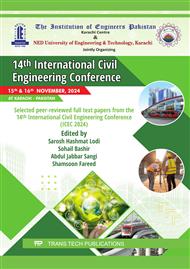p.181
p.191
p.205
p.213
p.223
p.233
p.241
p.249
p.255
Optimizing Granular Soil Properties with Marble Dust: A Case Study from Peshawar City
Abstract:
A The marble processing industry in the Peshawar region generates a significant amount of waste during the cutting and processing stages, with approximately 20 to 25% of the total processed stone ending up as waste. This waste is often disposed of in open land, causing severe environmental problems. To address these issues, this study investigates the use of waste marble dust for soil stabilization as an economical and sustainable solution, particularly in regions where granular material for backfilling is scarce. Granular soil (sand) samples were mixed with varying percentages of waste marble dust (3.5%, 7%, 14%, 21%, and 28% by dry weight of soil). A series of geotechnical tests, including specific gravity, sieve analysis, modified Proctor compaction tests, and large direct shear tests, were conducted on both natural and marble dust-stabilized soils. The modified Proctor tests identified an optimum moisture content and maximum dry density at a 14% marble dust mixture. Subsequent large direct shear tests on this optimum mixture revealed enhanced shear strength parameters, including improved cohesion and angle of internal friction. The results demonstrated that incorporating marble dust into granular soil significantly improved its geotechnical properties. At the optimum 14% marble dust content, the soil exhibited increased compactness and enhanced shear strength, making it a viable alternative to traditional backfill materials. This study not only offers a cost-effective approach to soil stabilization but also provides a sustainable solution for managing marble waste, contributing to environmental preservation especially for Peshawar city and the development of local construction projects.
Info:
Periodical:
Pages:
241-248
Citation:
Online since:
April 2025
Keywords:
Price:
Сopyright:
© 2025 Trans Tech Publications Ltd. All Rights Reserved
Share:
Citation:


